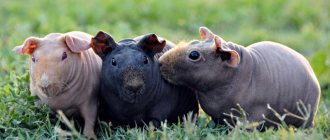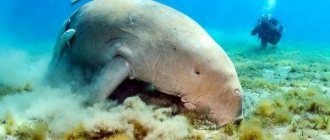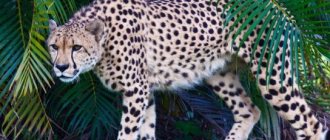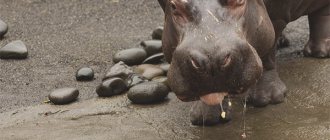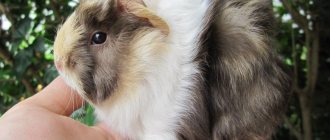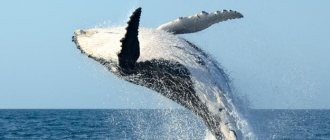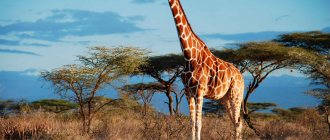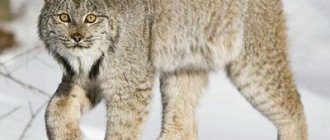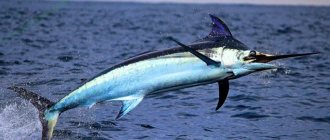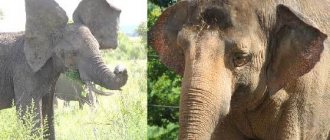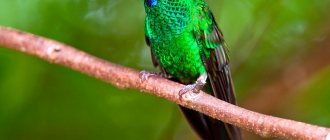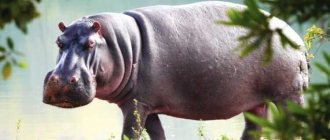The sea cow, or Steller's cow, or cabbage cow (Hydrodamalis gigas) is an extinct mammal from the dugong family, the order of sirenians. This animal was discovered by Georg Steller in 1741, when the ship of Vitus Bering's expedition was wrecked and the scientist was forced to settle on Bering Island, where he studied the local flora and fauna. The sea cow has only been found around the Commander Islands in the Bering Sea, between Russia and Alaska. The adult female was about 7.5 meters long and weighed up to about 3.5 tons.
Unfortunately, within 27 years of their discovery, sea cows became extinct. People hunted these slow-moving animals for their skin, fat and meat.
Origin of the species and description
Photo: Sea cow
The family began its development in the Miocene era. As they moved north of the Pacific Ocean, the animals adapted to the colder climate and grew in size. They ate cold-resistant sea plants. This process led to the emergence of sea cows.
Video: Sea cow
The species was first discovered by Vitus Bering in 1741. The navigator named the animal Steller's cow in honor of the German naturalist Georg Steller, a doctor traveling with the expedition. Most of the information about sirens is based on his descriptions.
Interesting fact: Vitus Bering's ship "St. Peter" crashed off an uncharted island. After landing, Steller noticed many bumps on the water. The animals were immediately nicknamed cabbage worms because of their love for kelp - seaweed. The sailors ate the creatures until they finally became stronger and set off on their further journey.
It was not possible to study unknown creatures, since the team needed to survive. Steller was initially sure that he was dealing with a manatee. In 1780, Ebberhart Zimmerman identified cabbageweed as a separate species. Swedish naturalist Anders Retzius gave it the name Hydrodamalis gigas in 1794, which literally translates to giant water cow.
Despite severe exhaustion, Steller was still able to describe the animal, its behavior and habits. None of the other researchers managed to see the creature live. Only their skeletons and pieces of skin have survived to this day. The remains are in 59 museums around the world.
In culture
Probably the most famous mention of the Steller's cow in works of classical literature is its image in Rudyard Kipling's story “The White Cat”.
In this work, the main character, a white seal, meets a herd of sea cows that have survived in a bay of the Bering Sea inaccessible to people.
Postage Stamp
The film “Once upon a time there were sea cows” is also dedicated to them, describing the history of Steller’s cows in general and the problems of the Kamchatka region of the RSFSR.
Video
Appearance and features
Photo: Sea or Steller's cow
According to Steller's description, the cabbages were dark brown, gray, almost black. Their skin was very thick and durable, bare and lumpy.
Together with their ancestor Hydromalis Cuesta, sea cows were larger and heavier than all aquatic inhabitants except whales:
- the length of a Steller cow is 7-8 meters;
- weight - 5 tons;
- neck circumference - 2 meters;
- shoulder circumference - 3.5 meters;
- abdominal circumference - 6.2 meters;
- the length of Hydrodamalis Cuesta is more than 9 meters;
- weight - up to 10 tons.
The body is thick, fusiform. The head, compared to the body, is very small. At the same time, mammals could move it in different directions, up and down. The body ended in a forked tail, shaped like a whale's. The hind limbs were missing. The front ones were flippers, at the end of which there was a growth called a horse's hoof.
A modern researcher who worked with a preserved piece of leather found that its elasticity was similar to that of modern car tires. There is a version that this property protected the sirens from damage from stones in shallow water.
The ears were practically invisible in the folds of skin. The eyes are small, about the size of a sheep's. On the upper, non-forked lip there were vibrissae as thick as a chicken feather. There were no teeth. The cabbage fish chewed its food using horny plates, one on each jaw. Judging by the preserved skeletons, there were about 50 vertebrae.
Males are slightly larger than females. There were practically no siren sounds. They only exhaled noisily, diving under the water for a long time. If they were wounded, they moaned loudly. Despite the well-developed inner ear, indicating good hearing, the creatures practically did not react to the noise made by the boats.
Now you know whether the sea cow is extinct or not. Let's see where these unusual animals lived.
Hunting
Industrialists who hunted sea otters there and researchers who arrived on the Commander Islands hunted Steller cows for their meat. The slaughter of cabbages was a simple matter - these lethargic and sedentary animals, unable to dive, could not escape from the people chasing them on boats. The harpooned cow, however, often showed such fury and strength that the hunters tried to swim away from it.
The usual method of catching Steller's cows was using a hand harpoon. Sometimes they were killed using firearms.
The main purpose of hunting the Steller's cow was to obtain meat. One of the participants in Bering's expedition said that up to 3 tons of meat could be obtained from a slaughtered cow. It is known that the meat of one cow was enough to feed 33 people for a month. Slaughtered cows were consumed not only by wintering parties; they were also usually taken with them as provisions by sailing ships. The meat of sea cows was, according to reviews of those who tried it, of excellent taste.
There is information that in 1755 the leadership of the settlement on the island. Bering issued a decree banning the hunting of sea cows. However, by that time the local population had apparently already been destroyed almost entirely.
Where does the sea cow live?
Photo: Sea cow in the water
Research shows that the mammals' range expanded during the peak of the last glaciation, when the Pacific and Northern oceans were separated by land where the Bering Strait is now. The climate at that time was milder and cabbageweeds settled along the entire coast of Asia.
Finds dating back to 2.5 million years ago confirm the existence of animals in this area. In the Holocene era, the range was limited to the Commander Islands. Scientists believe that in other places sirens may have disappeared due to persecution by primitive hunters. But some believe that by the time of the discovery the species was on the verge of extinction due to natural causes.
Despite data from Soviet sources, IUCN specialists found that in the 18th century, cabbage weeds lived off the Aleutian Islands. The first pointed out that the remains found outside the known distribution area were only corpses that were carried away by the sea.
In the 1960s and 1970s, parts of the skeleton were found in Japan and California. A relatively complete skeleton was found in 1969 on Amchitka Island. The age of the finds is 125-130 thousand years ago. The right rib of the animal was found on the coast of Alaska in 1971. Despite the small age of the sea cow, the size was equal to that of adult individuals from the Commander Islands.
Notes
- Life of animals. Volume 7. Mammals / ed. Sokolova V. E. (chief editor), Gilyarov M. S., Polyansky Yu. I. and others - 2nd ed. - M.: Education, 1989. - P. 403. - 558 p. — ISBN 5-09-001434-5
- Sokolov V. E.
Systematics of mammals. Volume 3. Cetaceans, carnivores, pinnipeds, aardvarks, proboscideans, hyraxes, sirens, artiodactyls, callouseds, odd-toed ungulates. - M.: Higher School, 1979. - P. 332. - 528 p. - ↑ Sokolov V. E.
Five-language dictionary of animal names. Mammals. Latin, Russian, English, German, French. / under the general editorship of academician. V. E. Sokolova. - M.: Rus. lang., 1984. - P. 121. - 10,000 copies. - ↑ Animal Life / ed.
S. P. Naumov and A. P. Kuzyakin. . - M.: “Enlightenment”, 1971. - T. 6 (mammals). - pp. 409-410. — 628 p. — 300,000 copies. - ↑
- ↑ (English). www.hans-rothauscher.de. Retrieved September 26, 2012.
- ↑ Murray Lundberg.
(English). Explore North. Retrieved September 26, 2012. - ↑ (English) (inaccessible link). California Academy of Sciences. Retrieved September 26, 2012.
- ↑ V. N. Kalyakin.
. Animal world. Retrieved September 25, 2012. - ↑ (English) (inaccessible link). Recently Extinct Animals (12 August 2006). Retrieved September 26, 2012.
- ↑. - cit. by Vakhrin S.I. “Meeting the Sun”, 1996. Date of access September 25, 2012.
- ↑. Age of Mammals. Retrieved September 25, 2012.
- . V. Dahl's dictionary online. Retrieved September 27, 2012.
- A. M. Tokranov.
. Retrieved September 27, 2012. - ↑ (English). Britannica Online Encyclopedia. Retrieved September 26, 2012.
- ↑. Animal world. — B. Grzimek. Abbreviation translation from German by E. A. Geevskaya from the book “Unsere Bruder mit den Krallen”. “Chemistry and Life” No. 11, 1981, p. 58-61. Retrieved September 25, 2012.
- ↑ Bret Weinstein, James Patton.
(English). Animal Diversity Web. Retrieved September 25, 2012. - ↑ ST Turvey1, CL Risley.
(English). Biology Letters. Retrieved September 25, 2012. - ↑ Frank C. Whitmore, Leonard Meade Gard.
(English). www.hans-rothauscher.de. — Geological Survey Professional Paper 1036; Washington, 1977. Retrieved September 26, 2012. - ↑ (English). The IUCN Red List of Threatened Species. Retrieved September 25, 2012.
- , 14:22−17:04.
- . Museums of Russia (2001-2010). Retrieved September 26, 2012.
- . Cultural Irkutsk - everything about the cultural life of Irkutsk (2005-2008). Retrieved September 26, 2012.
- ↑ (English). Around the world. - No. 10 (2613), October 1991. Retrieved September 26, 2012.
- Tom Muller.
(English) (inaccessible link). National Geographic - Russia (28 July 2011). Retrieved September 26, 2012. - Kipling, Rudyard Joseph.
(unavailable link). Electronic library ModernLib.ru. Retrieved September 27, 2012.
Best articles: Close-up geographical maps of Antarctica in Russian: physical and contour
What does a sea cow eat?
Photo: Cabbage, or sea cow
The mammals spent all their time in shallow water, where seaweed grew in abundance, on which they fed. The main food was seaweed, from which the sirens got one of their names. By eating algae, animals could stay under water for a long time.
Once every 4-5 minutes they surfaced to take a breath of air. At the same time they snorted noisily, like horses. Large quantities of roots and stems of the plants they eat accumulated in the cabbage moths' feeding areas. The thalli, along with droppings resembling horse manure, were washed ashore in large heaps by the waves.
In the summer, the cows ate most of the time, storing up fat, and in the winter they became so thin that their ribs could easily be counted. The animals pinched algae leaves with their flippers and chewed them with their toothless jaws. That is why only the pulp of sea grass was eaten.
Interesting fact: Dr. Steller described mammals as the most voracious animals he had ever seen. According to him, insatiable creatures constantly eat and are not interested in what is happening around them. In this regard, they lack the instinct of self-preservation. You can safely sail between them on boats and select an individual for slaughter. Their only concern was surfacing for breath.
Nutrition
Sea cows ate grass, as cows should. Clutching a kelp leaf with their flippers, they passed it through the upper forked lip. The tender pulp of the leaf went into the mouth, and the hard core was discarded.
According to Steller, the sea cow was found only around Bering Island. He also pointed out that by hunting these animals, it is possible to provide the inhabitants of Kamchatka with plenty of meat.
Features of character and lifestyle
Photo: Sea cow
The sirens spent most of their time in shallow water, well warmed by the sun, eating sea vegetation. They often rested their forelimbs on the bottom. The creatures did not know how to dive; their backs always stuck out on the surface. They dived only due to their high bone density and low buoyancy. This made it possible to stay at the bottom without significant energy consumption.
The backs of cows rose above the surface of the water, on which seagulls perched. Other seabirds also helped the sirens get rid of crustaceans. They pecked whale lice from the folds of the skin. Trusting animals came so close to the shore that sailors could touch them with their hands. In the future, this trait had a negative impact on their existence.
Cows were kept in families: mother, father and babies. They grazed in crowds, next to other cabbage grasses, and gathered in clusters of up to hundreds of individuals. The cubs were in the middle of the herd. The attachment between individuals was very strong. In general, the creatures were peaceful, slow and apathetic.
Interesting fact: Steller described how the partner of a killed female swam for several days to the killed female, which was lying on the shore. The baby cow that was killed by the sailors behaved in a similar way. Mammals were not at all vindictive. If they swam to the shore and were hurt, the creatures moved away, but soon returned again.
Extermination
The sea cow treated people with great confidence, swimming so close to the shores that one could even stroke it. But, unfortunately, many people had no time for tenderness, and the meat of the sea cow turned out to be tasty, in no way inferior to beef. The local population especially loved the lard of this mammal - it had a very pleasant smell and taste, and was superior in quality to the lard of other marine and domestic animals. This fat had the unique property of being stored for a long time even on the hottest days. The cow also gave milk - fatty and sweet, similar to sheep's milk.
In his works, Steller noted the extraordinary forgivingness of animals. If a sea cow swam too close to the shore was hurt, it would move away, but soon forget the insult and return again. Sea cows were caught using large hooks to which a long rope was tied. The catcher was in the boat, and about thirty people stood on the shore and held the rope.
A significant role in the disappearance of the sea cow was played by its excessive greed for food. These insatiable animals ate constantly, which forced them to keep their heads under water
Safety and caution were unknown to Steller's cows, and fishermen took advantage of the gullibility and carelessness of mammals - you could simply sail between them in boats and choose a suitable victim
Several complete skeletons of the sea cow, small pieces of skin and many scattered bones have survived to this day. Most of them have become museum exhibits, like the world's most complete skeleton of Steller's cow, which is kept in the Khabarovsk Museum of Local Lore. Grodekova. An important contribution to the study of the sea cow was made by the American zoologist of Norwegian origin, Steller biographer Leonard Steineger, who conducted research on the Commanders in 1882-1883 and collected a large number of bones of this animal.
Social structure and reproduction
Photo: Sea cow calf
Even though the cabbage grass grazed in groups, it was still possible to discern clusters of 2, 3, or 4 cows in the water. The parents did not swim far from the yearling calf and the baby born last year. Pregnancy lasted up to one year. Newborns were fed with mother's milk, between the flippers of which were the nipples of the mammary glands.
According to Steller's descriptions, the creatures were monogamous. If one of the partners was killed, the second did not leave the body for a long time and swam to the corpse for several days. Mating occurred mainly in early spring, but in general the breeding season lasted from May to September. In late autumn, the first newborns appeared.
Being apathetic creatures, males still fought for females. Reproduction occurred very slowly. In the overwhelming majority of cases, one cub was born per litter. Very rarely two calves were born. Mammals reached sexual maturity at the age of 3-4 years. The birth took place in shallow water. The kids were quite active.
Their dimensions were:
- length - 2-2.3 meters;
- weight - 200-350 kg.
Males do not take part in raising the young. While the mother is feeding, the babies cling to her back. They feed on milk upside down. They feed on mother's milk for up to one and a half years. Although at the age of three months they can pinch grass. Life expectancy reached 90 years.
general information
Dugongs are closely related to manatees and are commonly known as “sea cows” due to their peaceful grazing lifestyle. They have dull gray, torpedo-shaped bodies with flipper-like front legs and a small tail, similar in appearance to a dolphin's. The dugong lacks dorsal fins and hind limbs. Mature males have tusks.
Sea cows are very shy and do not like to be approached by researchers, making it difficult to study and obtain data on these elusive animals.
The dugong's closest relative, Steller's cow (or cabbage), was exterminated by humans within 27 years of its discovery in the 18th century.
Size
Adult dugongs can reach from 2.5 to 4 meters in length and weigh around 600 kilograms. By the way, the babies have no less impressive sizes - 1.2 meters in length and weight up to 30 kg.
Where does the dugong live?
Dugongs are found in coastal waters from the western Pacific Ocean to the eastern coast of Africa. They are strictly marine mammals, unlike manatees, which require fresh water.
They are highly dependent on their habitat, mainly due to the aquatic plants of the pondweed and aquatic family that make up their diet. Therefore, their habitat is coastal areas, bays and lagoons.
origin of name
The name "sea cows" comes from the fact that these animals love to feast on marine vegetation in shallow waters. Dugongs have very sensitive snouts that end in forked lips with vibrissa bristles.
What does the dugong eat?
This anatomy allows this relative of the manatee to easily pick off algae like a vacuum cleaner. If kelp beds are sparse at lunchtime, dugongs may feast on invertebrates such as jellyfish or small shellfish. Feeding usually occurs at a depth of 1 to 5 meters.
Lifestyle and reproduction
Dugongs become mature between 8 and 11 years of age. As males mature, their tusks will become visible and will further assist in the process of fighting to impregnate a female. Males do not participate in raising offspring.
In turn, females produce offspring throughout their lives. There is almost always one cub in one litter. It is very rare for a female to give birth to two at once. The gestation period lasts about a year. After birth, the mother feeds the baby with milk for 12–18 months, after which it begins to learn to eat algae on its own. As they grow up, babies like to gather in schools in shallow water, and in order to dive into the deeper layers of the ocean, they cling to the backs of their mothers.
Female dugong with baby
Because the seagrass beds cannot support large groups, dugongs are often solitary or live in pairs. And the main danger for them are large sharks, saltwater crocodiles and killer whales.
Threat of extinction
Although commercial hunting of dugongs has been banned, they are still listed as an endangered species on the Red List due to habitat loss from coastal development, as well as water pollution caused by industrial activities.
Animals can also become victims of fishing by becoming entangled in fishing nets.
Good sitrass habitat is vital for dugong reproduction. They have few natural predators, but in addition, young individuals are very susceptible to disease. In the end, I would like to supplement the story about these animals with some interesting facts:
In the end, I would like to supplement the story about these animals with some interesting facts:
- Life expectancy is more than 70 years.
- More closely related to elephants than to other marine mammals.
- Skin color may change due to the algae it consumes.
- The dugong sometimes “stands” on its tail, sticking its head out of the water.
- As soon as a small dugong is born, the mother pushes it to the surface so that it can breathe air.
- It is believed that sea cows inspired ancient storytellers to create images of mermaids and sirens.
- Dugongs and manatees are the only herbivorous marine mammals alive today.
- They love warm water.
- There may be more than 80,000 in Australian waters, representing more than half the world's total.
- The scientific name of the dugong is Dugong dugon.
Natural enemies of sea cows
Photo: Sea cow in the water
The forwarding doctor did not describe the animal's natural enemies. However, he noted that there have been repeated cases of sirens dying under the ice. There were situations when, during a strong storm, the waves were so high that the cabbage fish hit the rocks and died.
The danger came from sharks and cetaceans, but the most significant damage was caused to the sea cow population by humans. Vitus Bering, together with his group of navigators, were not only the discoverers of the species, but also caused its extinction.
During their stay on the island, the team ate cabbage meat, and upon returning home they told the world about their discovery. Fur traders, hungry for profit, went to new lands in search of sea otters, whose fur was very valuable. Numerous hunters filled the island.
Their target remained sea otters. They used cows exclusively as food. They killed them without counting them. More than they could eat and even pull onto land. Sea otters were able to survive the invasion of hunters, but the sirens could not survive their attacks.
Interesting fact: Forwarders noted that the meat of mammals was very tasty and resembled veal. The fat could be drunk in cups. It was stored for a very long time even in the hottest weather. In addition, the milk of Steller cows was sweet, like sheep's milk.
Relationship with other sirenids
Steller's cow is a typical representative of the sirenids. Its earliest known ancestor appears to have been the dugong-like Miocene sea cow, fossilized from California. A study of mitochondrial DNA showed that the evolutionary divergence of sea cows and dugongs occurred no later than 22 million years ago. Hydrodamalis cuestae can be considered the direct ancestor of the cabbageweed
, lived in the late Miocene, about 5 million years ago.
The closest modern relative of the Steller's cow is most likely the dugong. Steller's cow is classified in the same family as dugongs, but it is classified as a separate genus hydrodamalis
. All sirenians form a sister group to the proboscideans.
